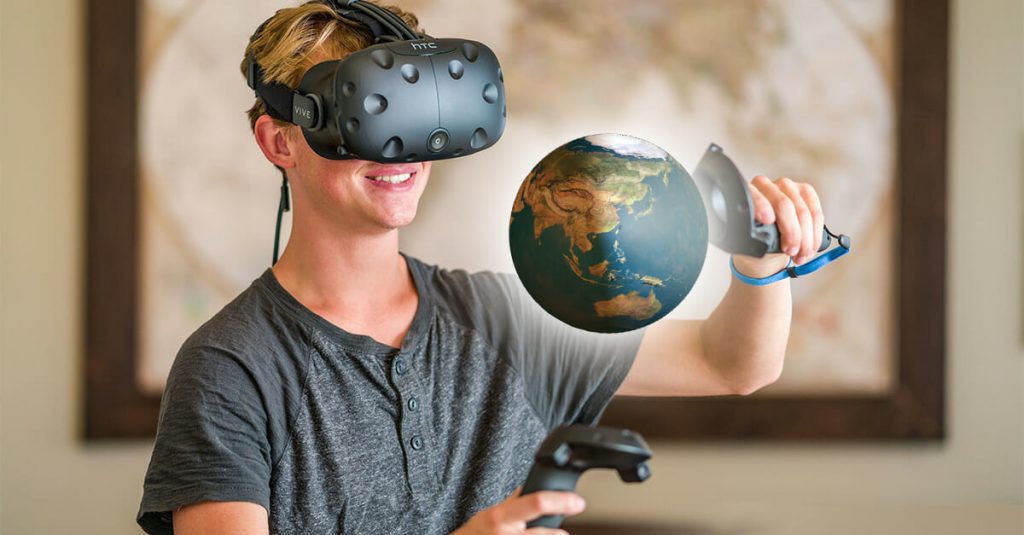Virtual reality has, without a doubt, changed the way we define computer technology. Reality is, indeed, relative, but, VR systems really managed to prove that there are no boundaries to the way we delineate what’s real and what was made to simulate what we generally perceive as being a reality.
VR tech isn’t limited to the entertainment industry (e.g., gaming, cinematography). Education, for instance, is one of many sectors where virtual reality really made a difference. Future doctors are now able to visualize, in real-time, how surgery will turn out, while those studying Ancient history are able to take a virtual stroll to long-forgotten places instead of reading about them in a book or looking at illustrations. In this article, we are going to talk more about the impact VR had and has on the educational system.
VR As a Game-Changer in Education
As we’ve mentioned in our intro, virtual reality has already begun to reshape the way that we see the educational process. Tablets and lightweight computers were the first step, but, as you probably have guessed, there isn’t much room for interaction or that genuine feedback that facilitates the learning process. This is where virtual reality comes leaping into action. By combining high-end technology with knowledge, we’ve been able to put together a teaching system that projects a different version of reality.
Using VR to Train Future Doctors
For instance, med and premed students can really stand to benefit from VR systems. Of course, nothing can ever replace human interaction or learning anatomy on a real human body, but instead of dull PowerPoint presentations, diagrams or endless pages that describe, let’s say, a surgical procedure, a system like this can show them interactive representations of the topic. Furthermore, trained medical professionals can anticipate the outcomes of a procedure before touching the patient.
If you would recall, Dr. Sergio Canavero, a reputed Italian neurosurgeon made headlines with the first head transplantation procedure performed on a human patient. During the months to come, Cannavaro and his associates used an upgraded version of HTC Vive to test various surgical approaches. Although the surgery was scrubbed clean due to the unethical ramifications, it did reveal a surprising fact – that virtual reality is an indispensable tool in the life-saving business.
Bringing VR to the Classroom
Still, the medical field isn’t the only one that reaped the benefits of virtual reality. Everything we know about the traditional classroom (e.g., teachers reciting facts from memory while using the chalkboard, outdated computers, and dull PowerPoint presentations) is about to change.
Imagine going to class in a room where there are no blackboards, no chalk, no projector. Just endless rows of virtual reality headsets hooked up to high-end computers. Sounds like a gamer’s dream come true, does it not? Well, it might be, but don’t forget that such a setup is meant for something more than killing some spare time. It could translate into a more efficient educational system powered by VR’s capabilities of demonstrating concepts and teaching through visual aids.
If you want to look at it this way, virtual reality is distancing yourself from reality, plunging into another just to learn more about the one you ‘drifted away from’ in the first place. Far from us to waxing poetics but, the fact of the matter is that VR is slowly taking over and, no pun intended, there’s not a thing we can do about it.
Bringing long-forgotten places to life is yet another example of the impact virtual reality has on education. For instance, Unimersiv , a company dedicated to VR experiences, offers virtual tours of ancient cities such as Rome. The guided tour takes users to various landmarks such as the Temple of Venus, the Arch of Constantine, the Circus Maximus, Nero’s Colossus or the Roman forum. Granted, it doesn’t outshine Ubisoft’s revival of Alexandria but does keep in mind that applications such as this one were made, mostly, for educational purposes.
The most interesting fact is that Unimersiv is just one of many websites that offer VR experiences. It’s one thing to read about how Rome looked like during the reign of Julius Caesar, but an entirely different story to see all those buildings, winding roads, aqueducts, taking shape right before your very eyes.
Speaking of education, the arts have had much to gain from virtual reality. Artists are now able to use a virtual canvas in order to give a shape to their ideas and emotions. Things like visual novels, interactive paintings or sculptures that come to life are no longer fantastic things you read about in a science-fiction novel but something very palpable and, dare we say so, quite accessible.
On that topic, gaming, albeit considered by many people as having nothing in common with art, is one of the many industries that took full advantage of virtual reality. For instance, websites like this one prove that not only VR has sprouted wings, but also the gaming industry under the baton of virtual reality, is beginning to look like something out of Michelangelo’s fever dreams.
Conclusion
Has virtual reality impacted education? Most definitely and the results speak for themselves. To the virtual fact-finding tours that take us to ancient cities to the surgical theater where lives are being saved, VR definitely gave us that thing we were looking for in terms of reshaping reality. Who knows what the future holds, but, we can state that this is just the beginning of a truly wondrous journey.
Many thanks to Robert Hyde for this guest post.



